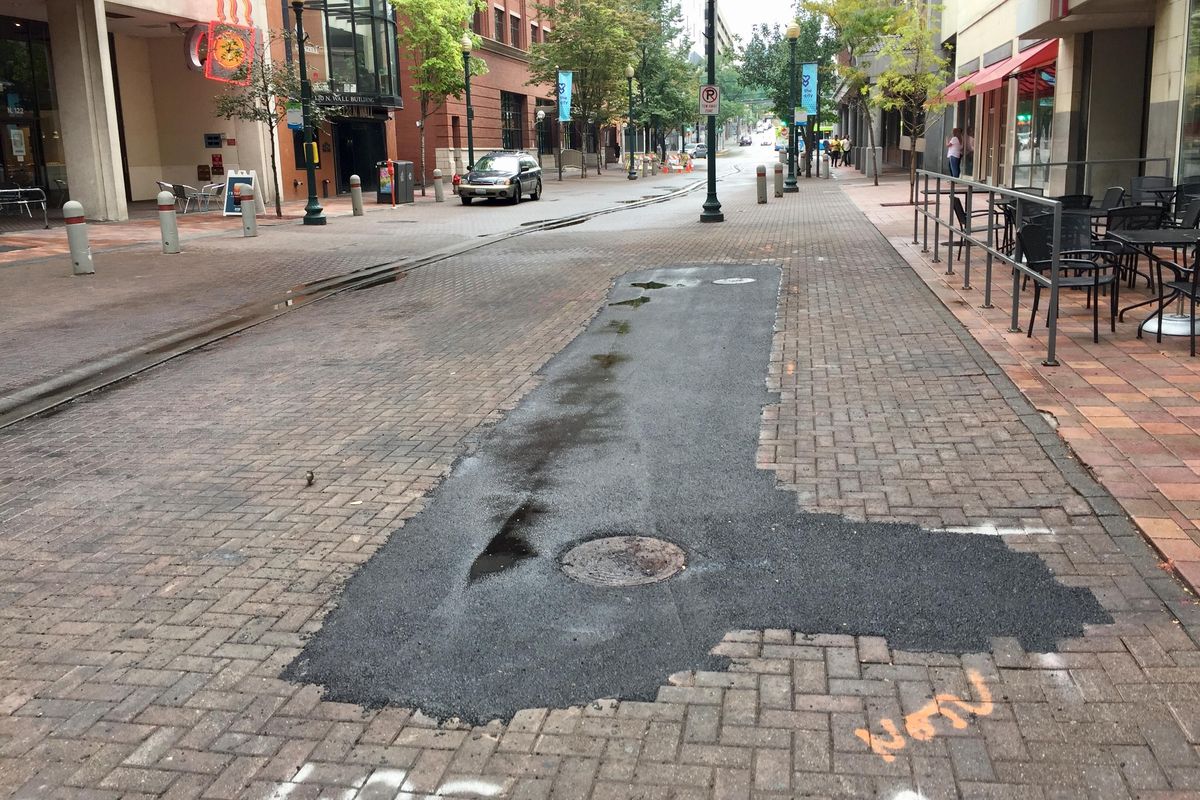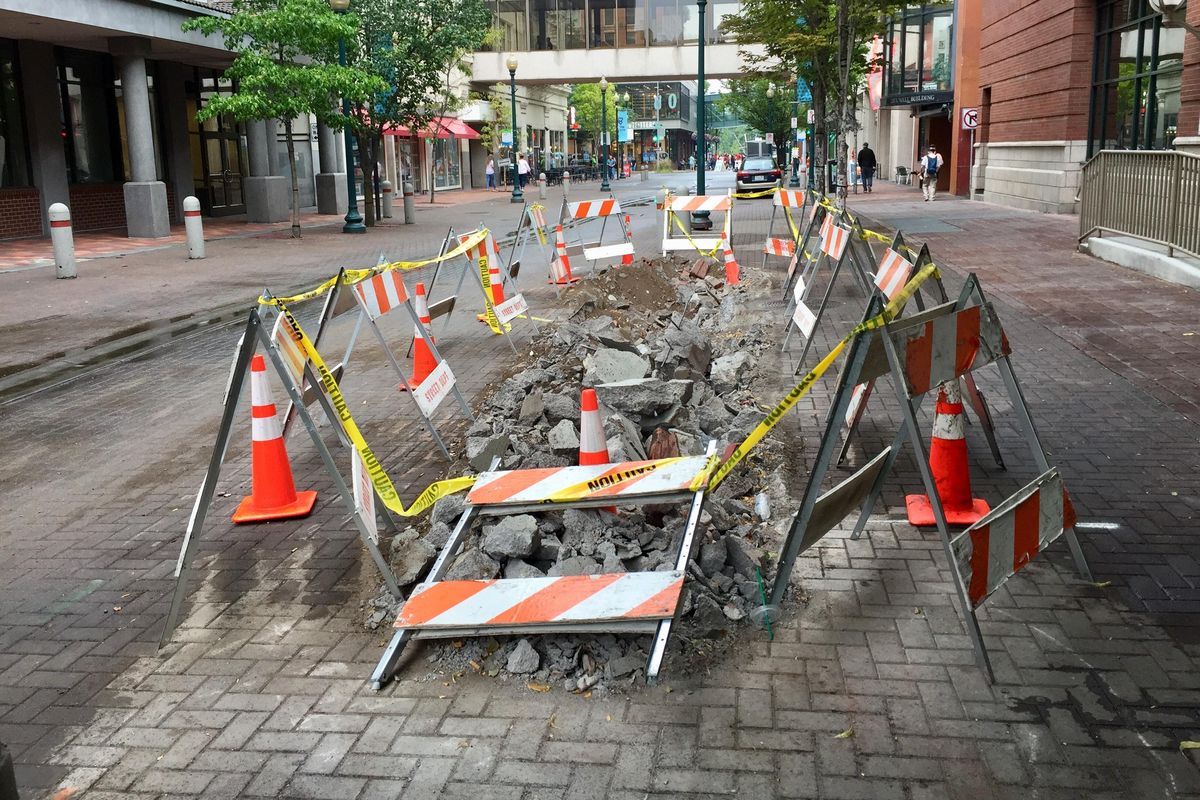Getting There: The new ways of Wall Street
Asphalt fills the space left behind after city crews removed a planter to make way for Spokane Transit Authority’s Central City Line. (Nicholas Deshais / The Spokesman-Review)
Last week, the brick-lined Wall Street in downtown Spokane lost two concrete planters – a place to sit, favored by those wishing to smoke a variety of things and a security guard to glare at them.
One was replaced by asphalt and only its outline remains, like a murderous chalk sketch seen in the movies. The other remains a toothy hole surrounded by barricades.
In a strange twist of happenstance, we can thank the Spokane Transit Authority for not only the planters themselves, but their removal. Simply put, they arrived for the trolley, but they were removed for the Central City Line.
Marlene Feist, a spokeswoman with the city, said work will begin next year on Wall, between Main and Riverside avenues, in preparation for the bus rapid transit line,, which will run between Browne’s Addition and Spokane Community College on a 6-mile loop through downtown Spokane beginning in 2022.
“There isn’t enough room to accommodate the CCL buses with those in place,” Feist said in an email regarding the planters. Removing seats for ne’er-do-wells was an added benefit.
“We have certainly heard concerns about loitering and related activity, to be sure, and removal of these planters will help address that as well,” she wrote.
A push for progress, transit or otherwise; that’s the story of Wall Street. It’s even baked into the name.
Before 1905, the street was called Mill Street, the name it was given by the city’s founders.
“Mill was so named because I expected the milling industry to center around its terminus at the river,” James Glover, the so-called “father” of Spokane, wrote in his memoirs.
Mill did thrive with industry, just not in the way Glover expected. Instead, saloons characterized the street in the city’s first decades. City leaders were displeased with such debauchery, and they asked saloon keepers to “find either a new location or a new trade,” according to an article in The Spokesman-Review.
They didn’t. John N. Squier’s saloon, later the Stockholm Saloon and Cafe, went nowhere until Prohibition became Washington state law in 1916. Well before voters prohibited the sale and manufacture of liquor, city leaders came up with a new plan to change Mill Street, with a simple name change.
In 1905, Mill Street became Wall Street, but only on the one block between Main and Riverside. The folks in charge had in mind Manhattan’s famous Wall Street, then and now the financial heart of the U.S. They wanted this little, one-block street to be the financial center of Spokane.
It had some effect. In 1906, a two-story building on this block of Wall was purchased by, and changed its name to, Hypotheekbank, which means “mortgage bank” in Dutch. On the corner of Riverside and Wall stood the old Marble Bank, but it faced Riverside. Other than that, though, there wasn’t much banking occurring on Wall.
It took six more years for the name change to take for the whole stretch of road, between city limits north and south.
Dreams of banking gave way to shopping at the Crescent. Soon enough, driving on Wall became the main event.
In 1953, the city converted Wall and Post Street to adjoining one-ways. Wall carried northbound traffic between Third Avenue and the river, Post went southbound. Within a month, traffic on Wall jumped by 33%, with traffic counts reaching about 1,500 cars a day. Engineers said the road still had plenty of capacity. The road had become just another commute, known more for traffic than whatever commerce played on its edges.
Forty years passed, and another conception of Wall emerged. A coalition of downtown business owners proposed closing Wall to traffic altogether. They envisioned a brick-lined pedestrian mall on three blocks of Wall, where no traffic would be allowed – expect for a privately-run trolley ferrying people between the Spokane Arena and downtown.
The “Trolley on Wall Street” plan gained traction, and STA won a $1 million federal grant to make the project a reality. The Spokesman reported that the trolley would be running through town by fall 1994. All that was needed was approval from the Spokane Park Board, the City Council, the STA board and downtown property owners. No problem.
In March 1994, the “complex, multi-agency, public-private transportation scheme flew into a wall,” the Spokesman reported, unashamed of its wordplay. The Park Board had voted to prevent the trolleys from running through Riverfront Park. Elected city leaders began questioning the plan, calling it a “back door” deal. Mayor Jack Geraghty asked publicly, without irony, “Who’s in charge?”
That same month, the City Council plowed ahead, and voted unanimously to turn two blocks of Wall – between Spokane Falls Boulevard and Riverside – into a “trolley bus mall.”
“Wall Street would be redesigned with wide sidewalks, plantings, benches and sidewalk cafes,” the Spokesman reported on the $1.5 million project. “A 24-foot roadway would wind down the middle to carry the buses and delivery vehicles.”
Work commenced, the trolleys never came, but the planters did. For 25 years, the brick street wound through downtown, waiting for a new type of bus that never came. Until now, that is. They’ve been removed to make way for a new STA plan. Instead of squat buses made to look like old-time trolleys, the street will host long, articulated electric buses.
Where the languorous smokers will go, however, is anyone’s guess.
In the city
A single lane of Spokane Falls Boulevard between Post and Monroe will continue to be closed through this Friday between 6 a.m. and 2 p.m. for work related to storm tank and plaza construction. Also related to the work, crews will remove and replace a section of roadway on northbound Monroe between Lincoln Street and Spokane Falls Boulevard beginning Monday, Aug. 19, and ending Friday, Aug. 23.
Beginning today, crews will start a grind and overlay maintenance project on Indiana Avenue between Monroe and Division streets. Watch for workers.
WSDOT work
Major restoration work on U.S. Route 2 north of Division Street from Wye to Farwell Road is affecting traffic. Work has been completed on ADA curb ramp updates, with crews moving to grinding and paving. Work is scheduled Monday through Saturday from 7 p.m. to 10 a.m., with possible lane closures. It is expected to be complete in the fall.

